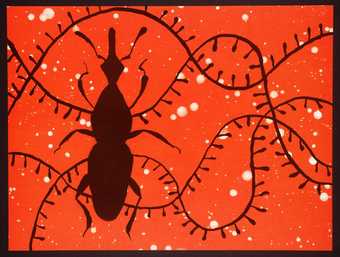
Yinka Shonibare CBE
Grain Weevil
(2000)
Tate
© Yinka Shonibare, courtesy Stephen Friedman Gallery, London
Animals and nature have always been a source of inspiration for artists. With a world of textures, colours and shapes around us to explore, we can discover new ways of seeing animals and connecting to our local environments through artwork.
On this page, you can find a selection of artworks in the Tate collection that explore our relationships with wildlife and nature, as well as discussion points and activities that offer useful prompts for your classroom.
Drawing with light
This activity invites your students to play with light and shapes. It will take 5-10 minutes and can be adapted to meet your students’ needs.
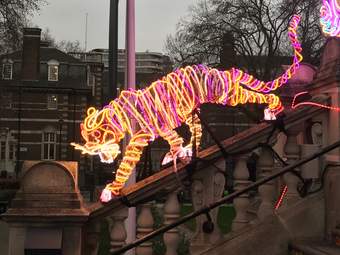
© Chila Kumari Singh Burman, Photograph by Tate (Zoë Smith)
Artist Chila Kumari Singh Burman works with light to make giant sculptures that tell stories. Have a look at her sculpture of a tiger, which was displayed outside Tate Britain.
You will need
- A few torches
- A camera
Instructions
- In small groups, take turns drawing an animal in the air using a torch. Can you guess what everyone is drawing?
- While someone is drawing, the rest of the group could trace the movements and make the shapes with your bodies or make a line drawing of what you see.
- Instead of guessing the animal’s name, the group could make animal sounds that match the animal being drawn with the torch. If you don’t know what sound to make, could you invent one?
- What happens if you try to take a photo of the light drawing?
Animals in our everyday
We all share our everyday lives with more animals than we could ever know! From the pets sharing our homes to the wildlife in our local environments, we can understand our relationships with animals and nature through artworks that depict them.
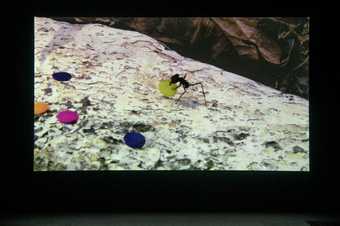
Rivane Neuenschwander, Cao Guimarães
Quarta-Feira de Cinzas / Epilogue
(2006)
Tate
Artists Rivane Neuenschwander and Cao Guimarães explore these ideas in Quarta-Feira de Cinzas / Epilogue (2006). In this film, many red and black ants carry shiny, colourful confetti across the rainforest floor in Brazil.
- Why are the ants carrying confetti? Where do you think they are going?
- Have you ever seen animals doing something unexpected like these ants?
This film has a very particular soundtrack, made using recordings of the ants and music played with matchsticks.
- What sounds do you think ants would make, if you could hear them?
- What do you think the ants would say to each other while carrying the confetti?
- Could you create an ant soundtrack of your own using objects in your classroom?
Discover more everyday animals in the Tate Collection through the links below:
- What other animals might we find in our everyday?
- How did they get there?
- What stories might these animals tell?
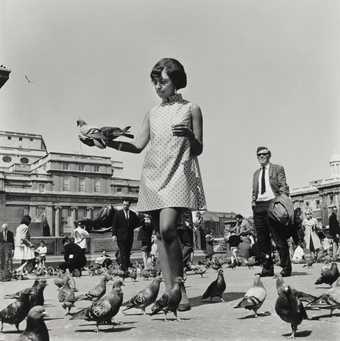
James Barnor
Drum Cover Girl Erlin Ibreck at Trafalgar Square, London
(1966, printed 2010)
Tate

Yinka Shonibare CBE
Grain Weevil
(2000)
Tate
© Yinka Shonibare, courtesy Stephen Friedman Gallery, London
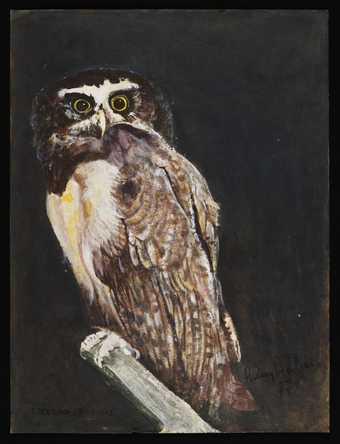
Aubrey Williams
Painting of a spectacled owl
(1977)
Tate Archive
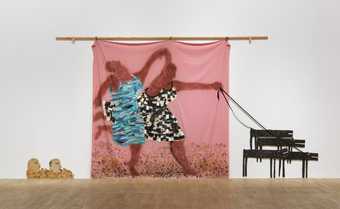
Lubaina Himid CBE RA
Freedom and Change
(1984)
Tate
© Lubaina Himid, courtesy the artist and Hollybush Gardens, London
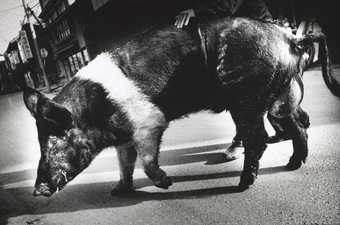
Daido Moriyama
Memory
(2012)
Tate
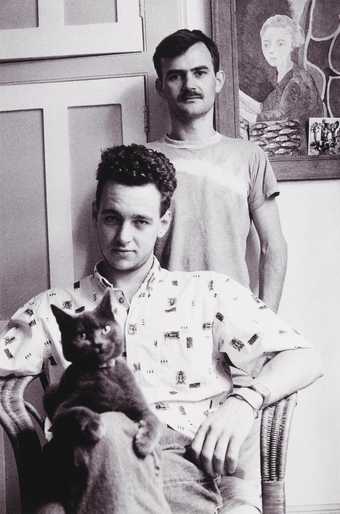
Sunil Gupta
Roger & Steve, London
(1984, printed 2018)
Tate
Making with natural materials
This activity invites your students to think about ways to be imaginative with natural materials and the importance of caring for our local environment. It will take around 20-30 minutes.
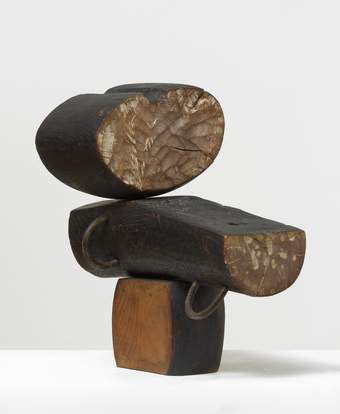
Kim Lim
Sphinx
(1959)
Tate
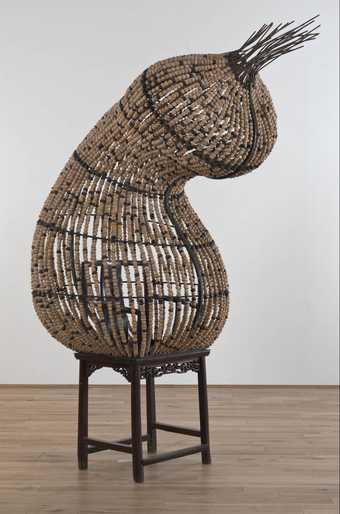
Chen Zhen
Cocon du Vide
(2000)
Tate
© The Estate of Chen Zhen, courtesy Galleria Continua, San Gimignano
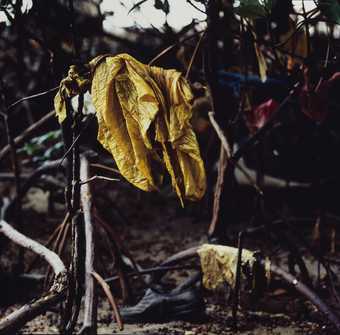
Simryn Gill
Channel #28
(2014)
Tate
Natural materials are a key feature of many artworks at Tate. Artists often consider the connections between us and our environments by using materials like clay, sticks, rocks, even feathers and animal bones! Have a look through the artworks shown above and think about what they tell us about animals and their homes.
You will need
- Natural materials such as twigs, leaves, rocks, tree bark, shells or feathers
- A camera to record your work, or paper and pens to make drawings
Instructions
- As a group, explore the local area around your school. Are there any green spaces nearby, somewhere where you might find plants, rocks, or other spaces where wildlife might live?
- Once you’ve found a good place, work together in pairs or small groups to collect natural material such as twigs, leaves, rocks, tree bark, shells, or feathers. Be careful of yourself and the environment as you go!
- In your groups, make a sculpture with your found material in the shape of an animal (real or imagined). What material could you use as fur, scales, or teeth?
- Leave your animal in its new home for someone else to find. How might the weather change them over time?
- You could make drawings or take photographs of your sculptures to take back to your classroom.
- Back at school, you can write stories or make more artwork inspired by your creations!
Animals in stories
What do animals mean to us? What can they mean in artworks?
Artworks often have many layers of meaning within them. Artists can use familiar images and ideas to tell specific stories through their work. Sometimes they are trying to make us see things in a particular way. Where do these meanings come from? What changes in an artwork if we don’t know this background?
We can learn a lot about an artwork by looking closely at the symbols the artist has chosen. Follow the links below to bring two example artworks into your classroom. Share them on your interactive whiteboard and ask your students to discuss them in small groups or pairs.
Marmaduke Cradock’s painting A Peacock and Other Birds in a Landscape has many native British birds surrounding a peacock, a bird from South Asia.
- Why do you think all of these birds are in this painting? What could their stories be?
- Why do you think the artist chose to make the peacock the focus of the painting and its title?
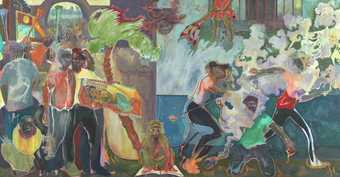
Michael Armitage
The Promised Land
(2019)
Tate
In Michael Armitage’s The Promised Land, we can see a monkey sitting under a tree in the middle of the painting, surrounded by crowds of people.
- What do you think the monkey is doing there?
- How do you think the monkey is feeling?
- What stories can you find in this painting?
More prompt questions
- What do you think is happening in these artworks?
- What do you think the animals would say to you or to each other if they could talk?
- Do you think the animals like the painting they are in?
- Do you think the artist has given the animals a job to do in the paintings? What are they there to say to you or make you think about?
- If the animals were acting in a play, what story would they be telling?
Animal collage
This activity invites your students to make their own artwork using found images of animals and the environment. It will take around 20-30 minutes.
Collaging is a technique that artists use to create art out of existing materials. By combining lots of different images and textures, you can tell new and exciting stories through art. Click the links below to explore three collage artworks from Tate's collection for inspiration.
- Which of the three collages are you most excited by? Why do you think this is?
- Where are your eyes drawn to in each artwork? Which materials are these bits made out of?
- What story is each collage trying to tell you?
Now make your own collage!
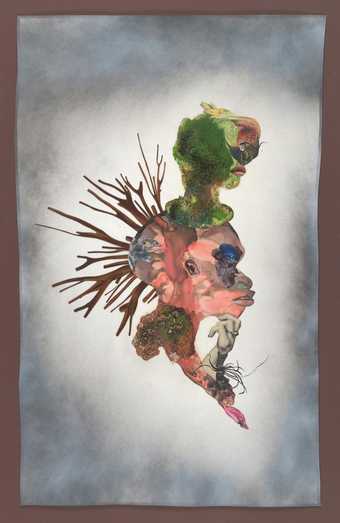
Wangechi Mutu
You were always on my mind
(2007)
Tate
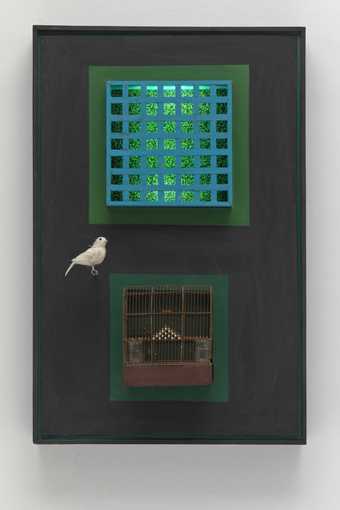
Parviz Tanavoli
Cage, cage, cage
(1966 (repaired 2009))
Tate
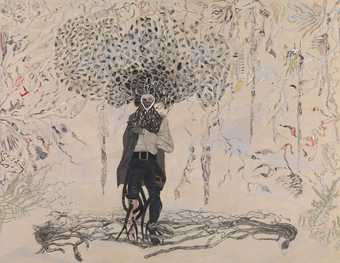
Ellen Gallagher
Bird in Hand
(2006)
Tate
You will need
- A selection of printed pictures from newspapers, magazines etc – encourage your students to bring in their own
- Glue and safety scissors
- Coloured and/or plain paper
- Drawing materials (pens, paints, crayons, glitter, or anything else you might have in your classroom)
- Natural material (feathers, tree bark, shells, flowers)
Instructions
- Look through the printed material that everyone has brought in and find an image of an animal that you like.
- Imagine a story about your chosen animal. Where does it live? What food does it eat? What does it get up to?
- Look for images of other animals, habitats, natural material, people, or buildings that can help you tell this story.
- Cut them out and make a collage of your story onto a sheet of paper.
- Use any extra paper you have, as well as colourful material or natural objects, to add to your artwork – can you make animals out of them too? What exciting creatures could you create?
- Share your stories with the rest of your class – could some of your animals talk to each other? What would happen if they met?
